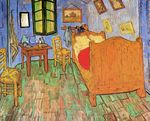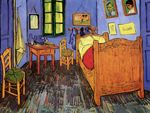ArtsVanGogh.com
Vincent van Gogh 1853-1890
Vincent van Gogh - Vincent's Bedroom in Arles 1888
/121 Vincent s Bedroom in Arles.jpg) Vincent's Bedroom in Arles |
From Wikipedia, the free encyclopedia:
Van Gogh started the first version during mid October 1888 while staying in Arles, and explained his aims and means to his brother Theo:
This time it simply reproduces my bedroom; but colour must be abundant in this part, its simplification adding a rank of grandee to the style applied to the objects, getting to suggest a certain rest or dream. Well, I have thought that on watching the composition we stop thinking and imagining. I have painted the walls pale violet. The ground with checked material. The wooden bed and the chairs, yellow like fresh butter; the sheet and the pillows, lemon light green. The bedspread, scarlet coloured. The window, green. The washbasin, orangey; the tank, blue. The doors, lilac. And, that is all. There is not anything else in this room with closed shutters. The square pieces of furniture must express unswerving rest; also the portraits on the wall, the mirror, the bottle, and some costumes. The white colour has not been applied to the picture, so its frame will be white, aimed to get me even with the compulsory rest recommended for me. I have depicted no type of shade or shadow; I have only applied simple plain colours, like those in crêpes.
Van Gogh included sketches of the composition in this letter as well as in a letter to Gauguin, written slightly later. In the letter, Van Gogh explained that the painting had come out of a sickness that left him bedridden for days. This version has on the wall to the right miniatures of Van Gogh's portraits of his friends Eugène Boch and Paul-Eugène Milliet. The portrait of Eugène Boch is called The Poet and the portrait of Paul Eugène Milliet is called The Lover
The Letters of Vincent van Gogh
To Theo van Gogh. Arles, on or about Monday, 14 May 1888.
My dear Theo,
Thanks for your letter containing 100 francs. I’m very glad to have left those people’s place, and my health is much better since. It was their bad food more than anything that made it drag on, and their wine, which was real poison. I now eat very well for one franc or 1.50 francs.
Tasset’s absorbent canvas would be just the thing for me if the canvas itself was three times as coarse. If you run into that gentleman see if you can find out what he uses as primer.
It wouldn’t surprise me if his canvas is prepared with pipeclay. If I had information about it I think I’d prepare the canvas myself. It’s not urgent — but see what you can find out. I still have 4 metres of canvas 1 metre 20 wide that I bought here, but it isn’t prepared yet. As soon as there’d be another consignment of colours, he could add primer to that consignment, enough to prepare 4 metres. But anyway, it’s not urgent yet. On your return did those gentlemen speak again about making you travel?
In the next few days you’ll see the Danish painter who was here arrive in Paris, I don’t know how to write his name (Moriés?). He’s going to see the Salon and will then go back to his country and come back to the south, in a year perhaps. His last three studies were better and more colourful than what he was doing before. I don’t know what he’ll do later. But he has a good character and I’m sorry he’s going away. I told him a Dutch painter was living with you, and if Koning would like to take him up the Butte Montmartre he’ll probably do some studies there.
I’ve talked to him a lot about the Impressionists, all of whom he knew by name or from having seen their paintings, and he’s very interested in the subject. He has a letter of introduction to Russell. He regained his health here and is now very well — he’s good for two years — but after that it would do him good to come back for this same reason of health.
What’s this new book on Daumier, L’homme et l’oeuvre? Have you seen the exhibition of the caricaturists?
I have two new studies, a bridge and the verge of a wide road.
Many of the subjects here are just — in character — the same as in Holland — the difference is in the colour. There’s sulphur everywhere where the sun beats down. You know that we saw a magnificent rose garden by Renoir. I imagined I would find similar subjects here, and that was indeed the case when the orchards were in blossom. Now the appearance of things has changed and nature has become much harsher. But what greenness and what a blue! I must say that the few landscapes by Cézanne that I know render it very, very well, and I regret not having seen more of them. The other day I saw a subject just like Monticelli’s beautiful landscape with the poplars that we saw at Reid’s. To find more of Renoir’s gardens you’d probably have to go towards Nice. I’ve seen very few roses here, although there are some, among others the big red roses they call Roses de Provence.
To find plenty of subjects is perhaps already something in itself. Provided the paintings are worth what they cost. If the Impressionists go up in value that may become the case. And after a few years’ work we could recoup the past to some extent.
And after a year I’ll have a quiet home of my own. I’m curious about what you’ll say about my consignment, I think it takes 10 days to go from here to Paris by goods train.
If the consignment includes some that are too poor, don’t show them. The reason I sent you the whole lot is that it will give you an idea of the things I’ve seen.
I need to go and look for a new subject, so thanking you very warmly for writing to me so soon, handshake to you and to Koning.
Ever yours,
Vincent


